Gilbert Smith Carabiner (USA)
Gilbert Smith, who lived in Buttermilk Falls (pc. New York), was a doctor in his main profession. Nevertheless, like many enthusiasts of that era, he showed great interest in small arms, and from a certain time he even tried to contribute to his further development. In the early fifties of the XIX century, G. Smith began to study the prospects for rifle systems, and soon made several new proposals. Since the middle of the decade, he has filed a number of applications for patents. Judging by the themes of these documents, the self-taught designer showed a special interest in breech-loading systems with loading cartridges.
Preliminary theoretical research continued until the summer of 1857, when G. Smith applied for the construction of a new weapon. The US patent for the number US 17644 secured for him the priority right to a new version of a single-shot carbine, as well as the original cartridge for it. The presence of the document allowed the gunsmith to launch the production of advanced weapons, as well as to begin its promotion in the market. As the main customer, which was quite expected, the American army was considered.
After examining the existing models and taking into account the needs of the army, G. Smith formed the overall look of the future carbine. He proposed to manufacture weapons that, with sufficient firepower, would have been reduced in size and weight. To improve the overall combat performance, it was proposed to use a special cartridge. At the same time, the carbine had to be equipped with a percussion mechanism of the type of time-tested capsule lock.
Special ammunition for "Carabin Smith" subsequently received the designation .50 Smith. This cartridge was a further development of existing ideas, carried out through the use of new material. The main element of the cartridge design G. Smith was a rubber sleeve. It was made in the form of a glass with a pilot hole in the bottom. The required weight of gunpowder was loaded into the cartridge case, and the Dultsee was closed with a lead bullet of 12,7 caliber mm. Own initiating charge was not provided. Gunpowder planned to ignite with a separate capsule. The cartridge assembly had an 0,863 inch length (21,92 mm) and a total inch 0,53 diameter (13,46 mm). Product weight - 363 Grana or 23,52 g.
The Smith Carbine project offered the manufacture of "overlapping" weapons without any own means of ammunition. Thus, the main aggregates of the carbine were a relatively long barrel, a two-part receiver housing a trigger mechanism, and a butt. Externally, the weapons differed little from other models of their time, but some of the characteristics made it recognizable.
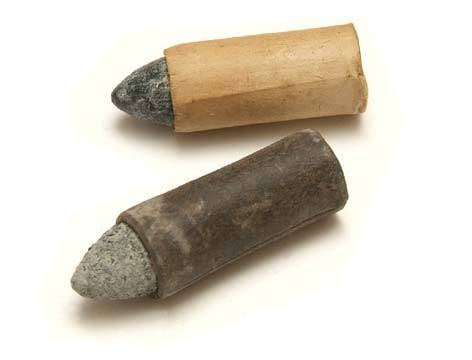
Original .50 Smith ammunition assembled on the basis of a rubber sleeve. Photo Guns.com
Mr. Smith believed that his carbine should be used primarily by cavalrymen and gunners, and for this reason to a certain extent reduced the dimensions of the weapon. The main way to reduce the size was to reduce the length of the barrel, which, however, did not adversely affect the firing characteristics. Losses in some parameters were compensated by gain in others.
The carabiner received a rifled barrel with a length of 21,6 inch (548,64 mm) or 43 caliber. The front part of the trunk had a circular cross-section, slightly increasing towards the breech. The breech, located under the forearm, differed octagonal outer surface. The breech bore had an external thread for installation in the front receiver unit. A seat for a movable adjustable front sight was provided near the muzzle. The octagonal part of the barrel had fastenings for mounting the sight and the locking spring plate. The latter prominently protruded beyond the breech and reached the receiver.
The barrel box of the carbine consisted of two parts, providing a "perelamyvanie" when recharging. The front part was a short block of complex shape, the upper part of which had a through hole and a thread for mounting the barrel. Bottom on the flat rear surface of such a unit there was a protrusion with a hole for the axis connecting the two parts of the receiver. Due to such a hinge, the front block with the barrel could swing relative to the main box.
Details of the trigger mechanism were mounted on a relatively simple rear part of the receiver. Its main element was a cast block with a large cavity inside, in the back of which there was a long shank for fitting the butt. On each side the cavity was covered with removable covers. The flat front end of this part served as a shutter and closed the breech of the barrel when fired. In the plate of the shutter, a brand tube began to appear on the right surface of the box. There was a rotating unit with a place to install the capsule. When rotated to the rearmost position, this detail allowed for a shot.
The trigger mechanism was composed of a trigger external location, internal combat spring and the trigger, which blocked the parts in the cocked position. The trigger was covered with a safety bracket. Arming was carried out manually before each shot. No automation of such processes was envisaged.
Gilbert Smith proposed the original barrel locking system that kept the weapon in a fighting position. On the upper surface of the breech bore was placed a leaf spring, which served as a lock. Its rear section, which was above the receiver, was more wide and had a rectangular opening in the middle. In the combat position of the carbine, this hole was put on the corresponding protrusion in the front of the rear block of the receiver and securely connected the weapon. To open the barrel to recharge, you had to press a special button inside the trigger bracket. She was made together with a vertical pod that lifted the shank of the plate-lock.
The weapon received the simplest sights. In the muzzle of the trunk was placed the front sight with the possibility of making lateral amendments. In front of the polygonal section of the barrel, an open sight was mounted with the setting of the firing range.
The carabiner was proposed to be completed with the traditional for that time wooden fittings. Under the octagonal section of the trunk with a ring and a screw fixed handguard of a small length. The rear projection of the receiver fastened with a butt that had a narrowed neck without a pistol projection. The stock was completed with a metal back plate. A narrow canal for transporting the ramrod ran along the entire length of a large wooden part.
In accordance with the developments of his time, Smith Carbine had to have specific means of fastening the belt. On the front ring, connecting the trunk and handguard, it was installed antab of the traditional type. She was brought to the left side of the weapon. The left side of the main part of the receiver is equipped with a longitudinal U-shaped frame. On it the ring which was carrying out functions of the second antabka freely moved. At the same time, at the request of the customer, the carbine could be equipped with two "classic" belt anchorages - the second was placed under the butt. Serial products for cavalry were completed with a frame and a ring, "artillery" carbines - with a pair of untabok on the forend and butt.
By reducing the size of the basic elements of the design G. Smith was able to get the total length of the weapon at the level of 39,5 inch (1003 mm). The loaded carabiner weighed the entire 7,5 pound (3,4 kg). Thus, the new product without any problems could be used by cavalrymen or gunners who needed compact systems with acceptable firepower.
The principles of the carbine G. Smith did not differ complexity. Before firing a shot, the shooter had to press the lock button and break the weapon. The cartridge was placed in the chamber, after which the carabiner could be “put together” and brought to its original state. Then a cap was put on the brand-tube and the trigger cocked. Hovering the weapon at the target, you could pull the trigger. The force of the flame from the capsule passed through the tube into the chamber and ignited the powder in the sleeve. Shot occurred. After that, it was necessary to open the weapon again, remove the burnt rubber sleeve and place a new ammunition in the chamber.
The reloading process was remarkable for a long time; however, in this case, Smith Carbine had noticeable advantages in the rate of fire over other samples of its time. One of the positive features of the new carbine was also associated with the liner material. When fired, the rubber sleeve literally inflated and sealed all the joints, preventing leakage of powder gases. Including thanks to this, the initial speed of the bullet was able to reach 950 feet per second (290 m / s).
Shortly after receiving a patent for a new design of the carbine and cartridge, G. Smith ordered a relatively small batch of serial products to one of the weapon companies. Three hundred carbines were intended for the implementation of some customers, as well as for army tests. According to reports, one of the first customers of such weapons was the postal company Pony Express. Shortly after the start of its operations in 1860, this organization acquired a certain number of carbines. They were planned to issue couriers for self-defense.
In the same year, G. Smith's carbines were tested in the Washington arsenal. Weapons showed good performance and could interest the military. In the near future the contract for the first batch of several thousand carbines was to appear. Already after the start of production of weapons in accordance with the new treaties in the United States, the Civil War began. The army of northerners needed large quantities of small arms, and Smith's carbines proved to be most welcome.
Serial production of such weapons lasted for several years. By the mid-sixties, the army got about 30360 carbines. Production of cartridges with a rubber sleeve was established in three factories. Over the same period, the industry has supplied over 13,8 million ammunition. Due to the simplicity of the design, the production carbines differed in their relatively low cost. One such item cost the army 24 dollars (about 680 dollars at current prices).
Smith Carbine passed on to various cavalry and artillery units. At a certain period, they were even able to become the most massive weapon of these types of troops. Carabiners were actively used in various battles and made a significant contribution to the victory of the North, both in individual battles and in the war as a whole.
However, it was not without problems. The massive production of .50 Smith cartridges required a large amount of rubber, but the United States was not able to get the raw materials in timely quantities in the required quantities. Ammunition manufacturers had to experiment with materials. Ammunition was produced with sleeves of different grades of paper, gutta-percha, or even a thin metal sheet. New "modifications" of the cartridge solved production problems, but led to new difficulties. Non-standard combustible materials led to increased contamination of the barrel and a reduction in the allowable number of shots between cleanings.
In 1862, Sharpe and Spencer rifles came into service, using relatively simple metal-filled cartridges. The latter could be produced in the desired quantities without any major problems. This fact most seriously hit the prospects of a carbine designed by G. Smith. The massive release of better weapons led to the gradual replacement of Smith Carbine in the army. By the end of the Civil War, a small number of such items remained in the army of the northerners. After the end of hostilities, the remnants of carbines were written off and sold on the civilian market.
New owners used such weapons for hunting and competition, but there were also special cases. A significant number of Smith's carbines fell into the hands of the so-called. Fenian brotherhood. From 1866 to 1871, the fighting units of this organization based in the USA made several raids on the border areas of Canada. In fact, the carbines went to the war for the second time and again showed, in general, quite good results.
The carbines of the war of the North and the South for several decades retained the status of mass civilian weapons, but over time their number was constantly decreasing. A significant number of such samples have survived to our time, but they are rare enough to have a relatively high price. In this case, the characteristic problem of carbines age one and a half centuries is the wear of parts. For example, the barrel locking system can no longer cope with its functions, and therefore the carbine can pose a danger to the shooter.
In the seventies of the XX century, several American workshops began to produce modern replicas of the carabiner G. Smith. Such products can exactly repeat the original design, or represent a modified version of it. New weapons are popular in circles historical reconstruction and among ordinary lovers of weapons of antiquity. The production of new cartridges using modern materials was also established.
It should be noted that some shooters prefer to manufacture their own .50 Smith type ammunition. In such a case, the existing lead bullet with suitable dimensions is taken as a basis, and the sleeve is made of available materials. Ready brass sleeves, plastic tubes or even rubber garden hoses are used. Despite the very specific origin, such cartridges fully comply with the requirements.
Dr. Gilbert Smith proposed some original ideas and implemented them in his own carbine project. Despite the clearly amateur nature of the project, the new weapon suited the military and was the subject of several major contracts. Due to the presence of certain problems indirectly related to the ideas of G. Smith, the carbines were eventually replaced by new systems, however, and after that they remained in operation, already as civilian weapons. However, the basic concepts of this project had no prospects. The development of new unitary cartridges with a metal sleeve was in full swing.
On the materials of the sites:
http://guns.com/
http://gunsandammo.com/
http://pietta.it/
http://navyarms.com/
http://perryadamsantiques.com/
http://google.com/patents/US14001
http://google.com/patents/US17644

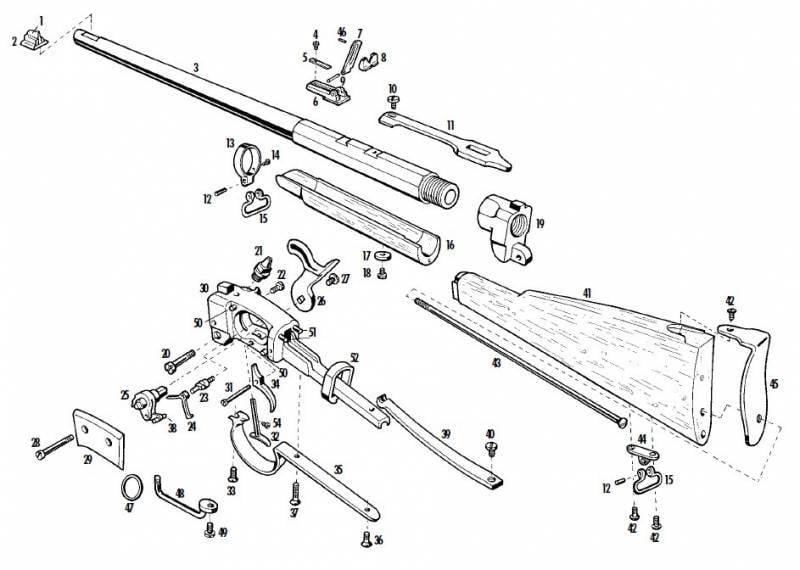

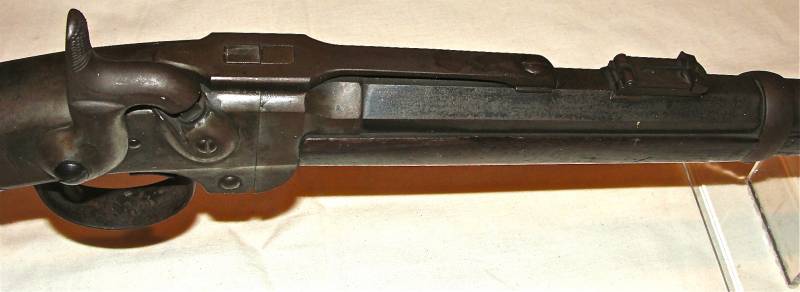
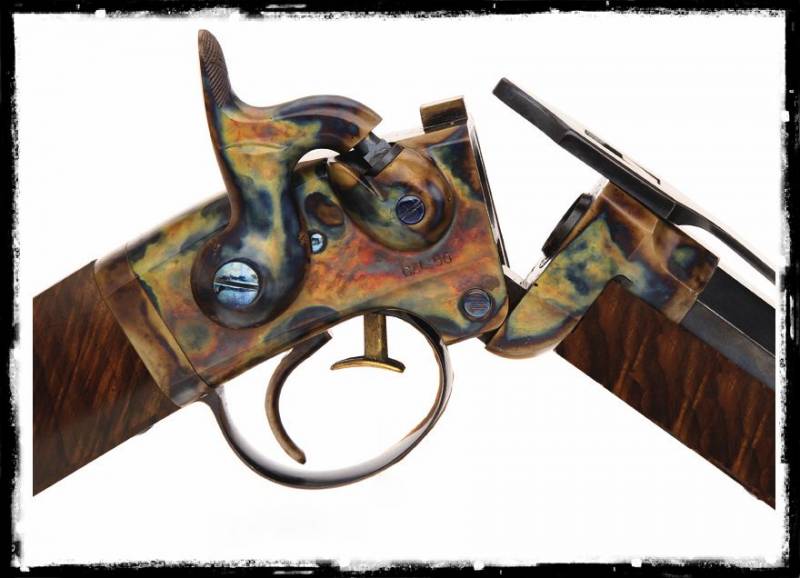
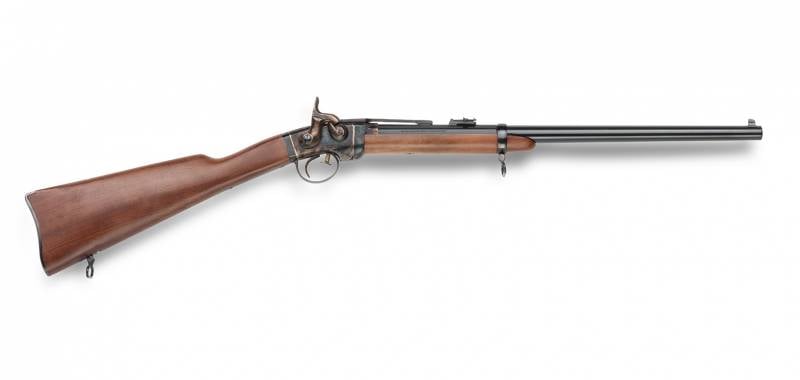
Information